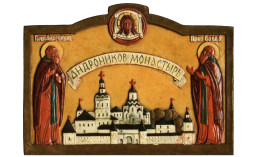
РАСПИСАНИЕ
на официальном сайте
https://andronikov-monastery.moscow
Среда 17 апреля 2024 года
Прп. Иосифа песнописца
7.00 Утреня. Часы
Изобразительны. Вечерня
ЛИТУРГИЯ ПРЕЖДЕОСВЯЩЕННЫХ ДАРОВ
архим. Дионисий
(византийское пение)
17.00 Утреня с чтением
ВЕЛИКОГО ПОКАЯННОГО КАНОНА ПРП. АНДРЕЯ
КРИТСКОГО.
Стояние Марии Египетской
Спасский собор
все духовенствое
(многоголосное пение)
Четверг 18 апреля 2024 года
Четверток Великого канона
8.00 Утреня. Часы
Изобразительны. Вечерня
ЛИТУРГИЯ ПРЕЖДЕОСВЯЩЕННЫХ ДАРОВ
все духовенствое
(многоголосное пение)
Пятница 19 апреля 2024 года
Свт. Евтихия, архиепископа Константино-польского
7.00 Утреня. Часы
Изобразительны. Вечерня
ЛИТУРГИЯ ПРЕЖДЕОСВЯЩЕННЫХ ДАРОВ
иерей Анатолий
(знаменный распев)
17.00 Утреня с чтением
акафиста Божией Матери
архим. Дионисий
(многоголосное пение)
Суббота 20 апреля 2024 года
Похвала Пресвятой Богородицы
Суббота Акафиста
8.00 Литургия.
архим. Дионисий
иерей Анатолий
(Многоголосное пение)
17.00 Всенощное бдение
все духовенство
(многоголосное пение)
Воскресенье 21 апреля 2024 года
ННеделя 5-я Великого поста
Прп. Марии Египетской
7.00 Ранняя литургия
Спасский собор
иерей Анатолий
(многоголосное пение)
9.00 Поздняя литургия
Спасский собор
архим. Дионисий
(многоголосное пение)
9.00 Поздняя Литургия.
храм св. Димитрия Донского
прот. Вячеслав
(знаменный распев)
11.00 ТАИНСТВО СОБОРОВАНИЯ (ЕЛЕОСВЯЩЕНИЯ)
Спасский собор
(архим. Дионисий)
(многоголосное пение)
17.00 ВЕЧЕРНЯ С ЧТЕНИЕМ АКАФИСТА
БОЖЕСТВЕННЫМ СТРАСТЯМ ХРИСТОВЫМ
архим. Дионисий
(многоголосное пение)
